#Curtiss P-40 in Australia
Explore tagged Tumblr posts
Text
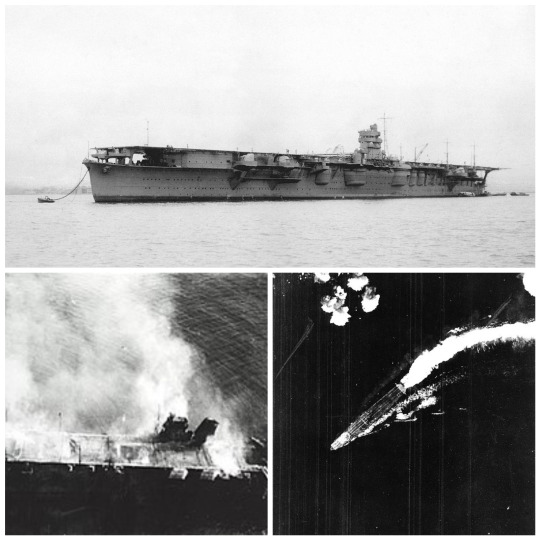
• IJN Aircraft Carrier Hiryū
Hiryū (飛龍, "Flying Dragon") was an aircraft carrier built for the Imperial Japanese Navy (IJN) during the 1930s. Generally regarded as the only ship of her class, she was built to a modified Sōryū design.
Hiryū was one of two large carriers approved for construction under the 1931–32 Supplementary Program. Originally designed as the sister ship of Sōryū, her design was enlarged and modified in light of the Tomozuru and Fourth Fleet Incidents in 1934–1935 that revealed many IJN ships were top-heavy, unstable and structurally weak. Her forecastle was raised and her hull strengthened. Other changes involved increasing her beam, displacement, and armor protection. The ship had a length of 227.4 meters (746 ft 1 in) overall, a beam of 22.3 meters (73 ft 2 in) and a draft of 7.8 meters (25 ft 7 in). She displaced 17,600 metric tons (17,300 long tons) at standard load and 20,570 metric tons (20,250 long tons) at normal load. Her crew consisted of 1,100 officers and enlisted men. Hiryū was fitted with four geared steam turbine sets with a total of 153,000 shaft horsepower (114,000 kW). Hiryū carried 4,500 metric tons (4,400 long tons) of fuel oil which gave her a range of 10,330 nautical miles (19,130 km; 11,890 mi) at 18 knots (33 km/h; 21 mph). The boiler uptakes were trunked to the ship's starboard side amidships and exhausted just below flight deck level through two funnels curved downward.
The carrier's 216.9-meter (711 ft 7 in) flight deck was 27 meters (88 ft 6 in) wide and overhung her superstructure at both ends, supported by pairs of pillars. Hiryū was one of only two carriers ever built whose island was on the port side of the ship (Akagi was the other). It was also positioned further to the rear and encroached on the width of the flight deck, unlike Sōryū. The flight deck was only 12.8 meters (42 ft) above the waterline and the ship's designers kept this figure low by reducing the height of the hangars. The upper hangar was 171.3 by 18.3 meters (562 by 60 ft) and had an approximate height of 4.6 meters (15 ft); the lower was 142.3 by 18.3 meters (467 by 60 ft) and had an approximate height of 4.3 meters (14 ft). Together they had an approximate total area of 5,736 square meters (61,740 sq ft). This caused problems in handling aircraft because the wings of a Nakajima B5N "Kate" torpedo bomber could neither be spread nor folded in the upper hangar. Aircraft were transported between the hangars and the flight deck by three elevators, the forward one abreast the island on the centerline and the other two offset to starboard.
Hiryū's primary anti-aircraft (AA) armament consisted of six twin-gun mounts equipped with 12.7-centimeter Type 89 dual-purpose guns mounted on projecting sponsons, three on either side of the carrier's hull. When firing at surface targets, the guns had a range of 14,700 meters (16,100 yd); they had a maximum ceiling of 9,440 meters (30,970 ft) at their maximum elevation of +90 degrees. Their maximum rate of fire was 14 rounds a minute, but their sustained rate of fire was approximately eight rounds per minute. The ship was equipped with two Type 94 fire-control directors to control the 12.7-centimeter (5.0 in) guns, one for each side of the ship; the starboard-side director was on top of the island and the other director was positioned below flight deck level on the port side. The ship's light AA armament consisted of seven triple and five twin-gun mounts for license-built Hotchkiss 25 mm Type 96 AA guns. Two of the triple mounts were sited on a platform just below the forward end of the flight deck. Hiryū had a waterline belt with a maximum thickness of 150 millimeters (5.9 in) over the magazines that reduced to 90 millimeters (3.5 in) over the machinery spaces and the gas storage tanks. It was backed by an internal anti-splinter bulkhead. The ship's deck was 25 millimeters (0.98 in) thick over the machinery spaces and 55 millimeters (2.2 in) thick over the magazines and gas storage tanks.
Following the Japanese ship-naming conventions for aircraft carriers, Hiryū was named "Flying Dragon". The ship was laid down at the Yokosuka Naval Arsenal on July 8th, 1936, launched on November 16th, 1937 and commissioned on July 5th, 1939. She was assigned to the Second Carrier Division on November 15th. In September 1940, the ship's air group was transferred to Hainan Island to support the Japanese invasion of French Indochina. In February 1941, Hiryū supported the blockade of Southern China. Two months later, the 2nd Carrier Division, commanded by Rear Admiral Tamon Yamaguchi, was assigned to the First Air Fleet, or Kido Butai, on April 10th. Hiryū returned to Japan on August 7th and began a short refit that was completed on September 15th. She became flagship of the Second Division from September 22nd to October 26th while Sōryū was refitting. In November 1941, the IJN's Combined Fleet, commanded by Admiral Isoroku Yamamoto, prepared to participate in Japan's initiation of a formal war with the United States by conducting a preemptive strike against the United States Navy's Pacific Fleet base at Pearl Harbor, Hawaii. On November 22nd, Hiryū, commanded by Captain Tomeo Kaku, and the rest of the Kido Butai, under Vice Admiral Chuichi Nagumo and including six fleet carriers from the First, Second, and Fifth Carrier Divisions, assembled in Hitokappu Bay at Etorofu Island. The fleet departed Etorofu, and followed a course across the north-central Pacific to avoid commercial shipping lanes. Now the flagship of the Second Carrier Division, the ship embarked 21 Mitsubishi A6M Zero fighters, 18 Aichi D3A "Val" dive bombers, and 18 Nakajima B5N "Kate" torpedo bombers. From a position 230 nmi (430 km; 260 mi) north of Oahu, Hiryū and the other five carriers launched two waves of aircraft on the morning of December 7th, 1941 Hawaiian time. In the first wave, 8 B5N torpedo bombers were supposed to attack the aircraft carriers that normally berthed on the northwest side of Ford Island, but none were in Pearl Harbor that day; 4 of the B5N pilots diverted to their secondary target, ships berthed alongside "1010 Pier" where the fleet flagship was usually moored. That ship, the battleship Pennsylvania, was in drydock and its position was occupied by the light cruiser Helena and the minelayer Oglala; all four torpedoes missed. The other four pilots attacked the battleships West Virginia and Oklahoma. The remaining 10 B5Ns were tasked to drop 800-kilogram (1,800 lb) armor-piercing bombs on the battleships berthed on the southeast side of Ford Island ("Battleship Row") and may have scored one or two hits on them, in addition to causing a magazine explosion aboard the battleship Arizona that sank her with heavy loss of life. The second wave consisted of 9 Zeros and 18 D3As, They strafed the airfield, and shot down two Curtiss P-40 fighters attempting to take off when the Zeros arrived and a Boeing B-17 Flying Fortress heavy bomber that had earlier diverted from Hickam Army Airfield, and also destroyed a Stinson O-49 observation aircraft on the ground for the loss of one of their own. The D3As attacked various ships in Pearl Harbor, but it is not possible to identify which aircraft attacked which ship.
While returning to Japan after the attack, Vice Admiral Chūichi Nagumo, commander of the First Air Fleet, ordered that Sōryū and Hiryū be detached on December 16th to attack the defenders of Wake Island who had already defeated the first Japanese attack on the island. The two carriers reached the vicinity of the island on December 21st and launched 29 D3As and 2 B5Ns, escorted by 18 Zeros, to attack ground targets. They encountered no aerial opposition and launched 35 B5Ns and 6 A6M Zeros the following day. The carriers arrived at Kure on 29 December. They were assigned to the Southern Force on January 8th, 1942 and departed four days later for the Dutch East Indies. The ships supported the invasion of the Palau Islands and the Battle of Ambon, attacking Allied positions on the island on January 23rd with 54 aircraft. Four days later the carriers detached 18 Zeros and 9 D3As to operate from land bases in support of Japanese operations in the Battle of Borneo. Hiryū and Sōryū arrived at Palau on January 28th and waited for the arrival of the carriers Kaga and Akagi. All four carriers departed Palau on February 15th and launched air strikes against Darwin, Australia, four days later. Hiryū contributed 18 B5Ns, 18 D3As, and 9 Zeros to the attack. Her aircraft attacked the ships in port and its facilities, sinking or setting on fire three ships and damaging two others. Hiryū and the other carriers arrived at Staring Bay on Celebes Island on February 21st to resupply and rest before departing four days later to support the invasion of Java. On March 1st, 1942, the ship's D3As damaged the destroyer USS Edsall badly enough for her to be caught and sunk by Japanese cruisers. Later that day the dive bombers sank the oil tanker USS Pecos. Two days later, they attacked Christmas Island and Hiryū's aircraft sank the Dutch freighter Poelau Bras before returning to Staring Bay on March 11th to resupply and train for the impending Indian Ocean raid.
On March 26th, the five carriers of the First Air Fleet departed from Staring Bay; they were spotted by a Catalina about 350 nautical miles (650 km; 400 mi) southeast of Ceylon on the morning of April 4th. Six of Hiryū's Zeros were on Combat Air Patrol (CAP) and helped to shoot it down. Hiryū contributed 18 B5Ns and 9 Zeros to the force; the latter encountered a flight of 6 Fairey Swordfish torpedo bombers from 788 Naval Air Squadron en route and shot them all down without loss. The Japanese aircraft encountered defending Hawker Hurricane fighters from Nos. 30 and 258 Squadrons RAF over Ratmalana airfield and Hiryū's fighters claimed to have shot down 11 with 3 Zeros damaged, although the fighters from the other carriers also made claims. On the morning of April 9th, Hiryū's CAP shot down another Catalina attempting to locate the fleet and, later that morning, contributed 18 B5Ns, escorted by 6 Zeros, to the attack on Trincomalee. The fighters engaged 261 Squadron RAF, claiming to have shot down two with two more shared with fighters from the other carriers. On April 19th, while transiting the Bashi Straits between Taiwan and Luzon en route to Japan, Hiryū, Sōryū, and Akagi were sent in pursuit of the American carriers Hornet and Enterprise, which had launched the Doolittle Raid against Tokyo. They found only empty ocean, as the American carriers had immediately departed the area to return to Hawaii. The carriers quickly abandoned the chase and dropped anchor at Hashirajima anchorage on April 22nd. Having been engaged in constant operations for four and a half months, the ship, along with the other three carriers of the First and Second Carrier Divisions, was hurriedly refitted and replenished in preparation for the Combined Fleet's next major operation, scheduled to begin one month hence. While at Hashirajima, Hiryū's air group was based ashore at Tomitaka Airfield, near Saiki, Ōita, and conducted flight and weapons training with the other First Air Fleet carrier units.
Concerned by the US carrier strikes in the Marshall Islands, Lae-Salamaua, and the Doolittle raids, Yamamoto was determined to force the US Navy into a showdown to eliminate the American carrier threat. He decided to invade and occupy Midway Atoll, which he was sure would draw out the American carriers to defend it. The Japanese codenamed the Midway invasion Operation MI. Unknown to the Japanese, the US Navy had divined the Japanese plan by breaking its JN-25 code and had prepared an ambush using its three available carriers, positioned northeast of Midway. On May 25th, 1942, Hiryū set out with the Combined Fleet's carrier striking force in the company of Kaga, Akagi, and Sōryū, which constituted the First and Second Carrier Divisions, for the attack on Midway. Her aircraft complement consisted of 18 Zeros, 18 D3As, and 18 B5Ns. on June 4th, 1942, Hiryū's portion of the 108-plane airstrike was an attack on the facilities on Sand Island with 18 torpedo bombers, one of which aborted with mechanical problems, escorted by nine Zeros. The air group suffered heavily during the attack: two B5Ns were shot down by fighters, with a third falling victim to AA fire. The carrier also contributed 3 Zeros to the total of 11 assigned to the initial CAP over the four carriers. By 07:05, the carrier had 6 fighters with the CAP which helped to defend the Kido Butai from the first US attackers from Midway Island at 07:10. Hiryū reinforced the CAP with launches of 3 more Zeros at 08:25. These fresh Zeros helped defeat the next American air strike from Midway. Although all the American air strikes had thus far caused negligible damage, they kept the Japanese carrier forces off-balance as Nagumo endeavored to prepare a response to news, received at 08:20, of the sighting of American carrier forces to his northeast.
Hiryū began recovering her Midway strike force at around 09:00 and finished shortly by 09:10. The landed aircraft were quickly struck below, while the carriers' crews began preparations to spot aircraft for the strike against the American carrier forces. The preparations were interrupted at 09:18, when the first attacking American carrier aircraft were sighted. Hiryū launched another trio of CAP Zeros at 10:13 after Torpedo Squadron 3 (VT-3) from Yorktown was spotted. Two of her Zeros were shot down by Wildcats escorting VT-3 and another was forced to ditch. While VT-3 was still attacking Hiryū, American dive bombers arrived over the Japanese carriers almost undetected and began their dives. It was at this time, around 10:20, that in the words of Jonathan Parshall and Anthony Tully, the "Japanese air defenses would finally and catastrophically fail." Three American dive bomber squadrons now attacked the three other carriers and set each of them on fire. Hiryū was untouched and proceeded to launch 18 D3As, escorted by six Zeros, at 10:54. Yamaguchi radioed his intention to Nagumo at 16:30 to launch a third strike against the American carriers at dusk (approximately 18:00), but Nagumo ordered the fleet to withdraw to the west. At this point in the battle, Hiryū had only 4 air-worthy dive-bombers and 5 torpedo-planes left. She also retained 19 of her own fighters on board as well as a further 13 Zeros on CAP (a composite force of survivors from the other carriers). At 16:45, Enterprise's dive bombers spotted the Japanese carrier and began to maneuver for good attacking position while reducing altitude. Hiryū was struck by four 1,000-pound (450 kg) bombs, three on the forward flight deck and one on the forward elevator. The explosions started fires among the aircraft on the hangar deck. The forward half of the flight deck collapsed into the hangar while part of the elevator was hurled against the ship's bridge. The fires were severe enough that the remaining American aircraft attacked the other ships escorting Hiryū, albeit without effect, deeming further attacks on the carrier as a waste of time because she was aflame from stem to stern. Beginning at 17:42, two groups of B-17s attempted to attack the Japanese ships without success, although one bomber strafed Hiryū's flight deck, killing several anti-aircraft gunners. Although Hiryū's propulsion was not affected, the fires could not be brought under control. At 21:23, her engines stopped, and at 23:58 a major explosion rocked the ship. The order to abandon ship was given at 03:15, and the survivors were taken off by the destroyers Kazagumo and Makigumo. Yamaguchi and Kaku decided to remain on board as Hiryū was torpedoed at 05:10 by Makigumo as the ship could not be salvaged. Around 07:00, one of Hōshō's Yokosuka B4Y aircraft discovered Hiryū still afloat and not in any visible danger of sinking. The aviators could also see crewmen aboard the carrier, men who had not received word to abandon ship. They finally launched some of the carrier's boats and abandoned ship themselves around 09:00. Thirty-nine men made it into the ship's cutter only moments before Hiryū sank around 09:12, taking the bodies of 389 men with her. The loss of Hiryū and the three other IJN carriers at Midway, comprising two thirds of Japan's total number of fleet carriers and the experienced core of the First Air Fleet, was a strategic defeat for Japan and contributed significantly to Japan's ultimate defeat in the war. In an effort to conceal the defeat, the ship was not immediately removed from the Navy's registry of ships, instead being listed as "unmanned" before finally being struck from the registry on 25 September 1942. The IJN selected a modified version of the Hiryū design for mass production to replace the carriers lost at Midway. Of a planned program of 16 ships of the Unryū class, only 6 were laid down and 3 were commissioned before the end of the war.
#second world war#world war 2#world war ii#wwii#military history#history#long post#naval history#imperial japan#japanese navy#japanese history#aircraft carrier#ships#midway
75 notes
·
View notes
Photo
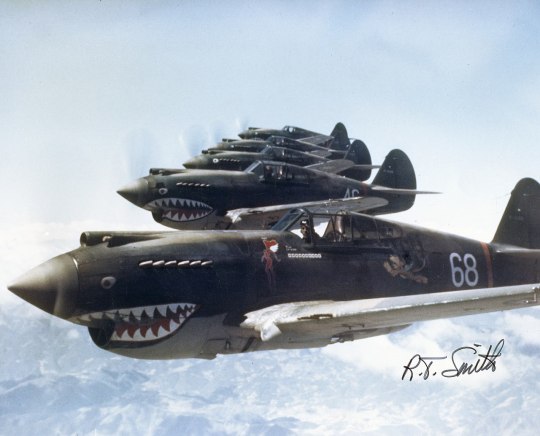
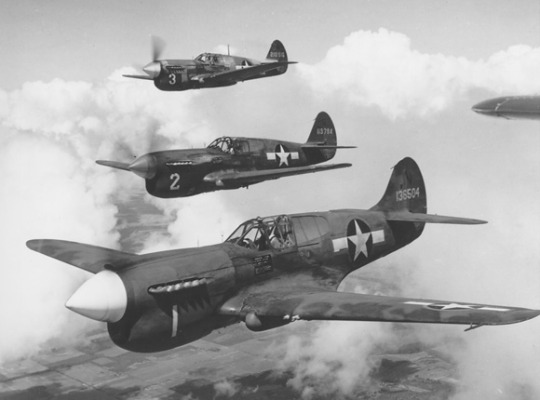

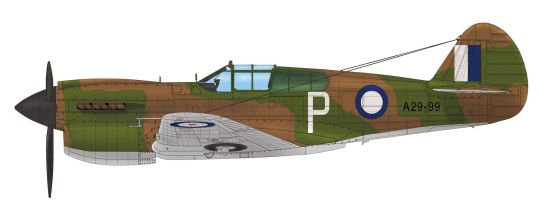

The Curtiss P-40 Warhawk is an American single-engined, single-seat, all-metal fighter and ground-attack aircraft that first flew in 1938. The P-40 design was a modification of the previous Curtiss P-36 Hawk which reduced development time and enabled a rapid entry into production and operational service. The Warhawk was used by most Allied powers during World War II, and remained in frontline service until the end of the war. It was the third most-produced American fighter of World War II, after the P-51 and P-47; by November 1944, when production of the P-40 ceased, 13,738 had been built,[3] all at Curtiss-Wright Corporation's main production facilities in Buffalo, New York.
P-40 Warhawk was the name the United States Army Air Corps gave the plane, and after June 1941, the USAAF adopted the name for all models, making it the official name in the U.S. for all P-40s. The British Commonwealth and Soviet air forces used the name Tomahawk for models equivalent to the original P-40, P-40B, and P-40C, and the name Kittyhawk for models equivalent to the P-40D and all later variants.
P-40s first saw combat with the British Commonwealth squadrons of the Desert Air Force in the Middle East and North African campaigns, during June 1941.[4][5] No. 112 Squadron Royal Air Force, was among the first to operate Tomahawks in North Africa and the unit was the first Allied military aviation unit to feature the "shark mouth" logo,[6][7] copying similar markings on some Luftwaffe Messerschmitt Bf 110 twin-engine fighters.[6] [N 1]
The P-40's lack of a two-speed supercharger made it inferior to Luftwaffe fighters such as the Messerschmitt Bf 109 or the Focke-Wulf Fw 190 in high-altitude combat and it was rarely used in operations in Northwest Europe. However, between 1941 and 1944, the P-40 played a critical role with Allied air forces in three major theaters: North Africa, the Southwest Pacific, and China. It also had a significant role in the Middle East, Southeast Asia, Eastern Europe, Alaska and Italy. The P-40's performance at high altitudes was not as important in those theaters, where it served as an air superiority fighter, bomber escort and fighter-bomber. Although it gained a postwar reputation as a mediocre design, suitable only for close air support, more recent research including scrutiny of the records of individual Allied squadrons indicates that this was not the case: the P-40 performed surprisingly well as an air superiority fighter, at times suffering severe losses, but also inflicting a very heavy toll on enemy aircraft.[9] Based on war-time victory claims, over 200 Allied fighter pilots – from the UK, Australia, New Zealand, Canada, South Africa, the US and the Soviet Union – became aces flying the P-40. These included at least 20 double aces,[10] mostly over North Africa, China, Burma and India, the South West Pacific and Eastern Europe. The P-40 offered the additional advantages of low cost and durability, which kept it in production as a ground-attack aircraft long after it was obsolescent as a fighter.
https://en.wikipedia.org/wiki/Curtiss_P-40_Warhawk
4 notes
·
View notes
Video
Curtiss P-40F Kittyhawk 'X-17' (VH-PIV) by Alan Wilson Via Flickr: This is the first Merlin engined P-40 to appear at shows in the UK. US military serial '41-19841' msn reported as both 19503 & 2991. This is a TFC aircraft and had only arrived after restoration in Australia the week before this show. Parked on the grass flightline. Flying Legends 2011. Duxford. 10-7-2011
8 notes
·
View notes
Video
youtube
The Curtiss P-40 Warhawk is an American single-engined, single-seat, all-metal fighter and ground-attack aircraft that first flew in 1938. The P-40 design was a modification of the previous Curtiss P-36 Hawk which reduced development time and enabled a rapid entry into production and operational service. The Warhawk was used by most Allied powers during World War II, and remained in frontline service until the end of the war. It was the third most-produced American fighter of World War II, after the P-51 and P-47; by November 1944, when production of the P-40 ceased, 13,738 had been built,all at Curtiss-Wright Corporation's main production facilities at Buffalo, New York.
P-40 Warhawk was the name the United States Army Air Corps gave the plane, and after June 1941, the USAAF adopted the name for all models, making it the official name in the U.S. for all P-40s. The British Commonwealth and Soviet air forces used the name Tomahawk for models equivalent to the original P-40, P-40B, and P-40C, while the name Kittyhawk for models equivalent to the P-40D and all later variants.
P-40s first saw combat with the British Commonwealth squadrons of the Desert Air Force in the Middle East and North African campaigns, during June 1941. No. 112 Squadron Royal Air Force, was among the first to operate Tomahawks in North Africa and the unit was the first Allied military aviation unit to feature the "shark mouth" logo, copying similar markings on some Luftwaffe Messerschmitt Bf 110 twin-engine fighters.
The P-40's lack of a two-speed supercharger made it inferior to Luftwaffe fighters such as the Messerschmitt Bf 109 or the Focke-Wulf Fw 190 in high-altitude combat and it was rarely used in operations in Northwest Europe. However, between 1941 and 1944, the P-40 played a critical role with Allied air forces in three major theaters: North Africa, the Southwest Pacific, and China. It also had a significant role in the Middle East, Southeast Asia, Eastern Europe, Alaska and Italy. The P-40's performance at high altitudes was not as important in those theaters, where it served as an air superiority fighter, bomber escort and fighter-bomber. Although it gained a postwar reputation as a mediocre design, suitable only for close air support, more recent research including scrutiny of the records of individual Allied squadrons indicates that this was not the case: the P-40 performed surprisingly well as an air superiority fighter, at times suffering severe losses, but also inflicting a very heavy toll on enemy aircraft. Based on war-time victory claims, over 200 Allied fighter pilots – from the UK, Australia, New Zealand, Canada, South Africa, the US and the Soviet Union – became aces flying the P-40. These included at least 20 double aces, mostly over North Africa, China, Burma and India, the South West Pacific and Eastern Europe. The P-40 offered the additional advantages of low cost and durability, which kept it in production as a ground-attack aircraft long after it was obsolete as a fighter
6 notes
·
View notes
Photo
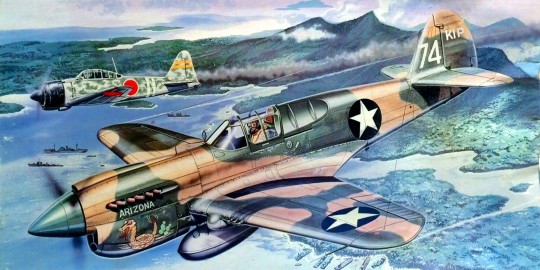
1942 02 Darwin, Australia Curtiss P-40E 'Arizona' - Don Greer
https://www.pacificwrecks.com/aircraft/p-40/41-5551.html
61 notes
·
View notes
Text
USAAF P-40's in Java
A series of articles focusing on the ill-fated efforts to bolster the Dutch defences against the Japanese onslaught early 1942 . Four squadrons of P-40 Warhawks were sent on a 6000 mile journey - from Brisbane, Australia to Java. Of the 83 that set out, only 30 ever reached their destination. And they went down fighting against overwhelming odds...

Follow all instalments on https://thejavagoldblog.wordpress.com/
#p-40 warhawk#usaaf in Java#US P-40's in Java#USAAF P-40's Pacific#Curtiss P-40#Curtiss P-40 in Australia#Curtiss P-40 in Java#curtiss p-40 warhawk#pacific war#17th Pursuit Sqn on Java#20th Pursuit Squadron on Java#Darwin in WW2#USAAF in Darwin Australia#Curtiss P-40's on Timor
0 notes
Text
The 10 Historic Aircrafts Of The USA
Happy Natal Day to Air Force! Hope you have many more years to Fly-Fight-Win wherein you Aim High. Although the US military bought the first aircraft in the year 1909, the United States Air Force didn’t exist as an independent and a separate branch until 18th of September, 1947.
For 75 years now, American Airmen have stand-out as they executed the Air Force task to fly, clash, and to win — giving airpower anywhere, anytime, in defense of the country.
History
The U.S. War division made the first ever antecedent of the United States Air Force, as part of the United States Army, on August 1, 1907, which by the succession of modification of titles, organization, and missions advanced to eventual independence after 40 years. In WW II, around 68,000 U.S. airmen were gone in helping to succeed in the war, with just an infantry suffering more fatalities. After the establishment of the Department of Air Force, in September 18, 1947, the primary secretary of Air Force, Mr. W. Stuart Symington, sworn into the office that the Air Force was formally formed as one independent service branch. So let us know now the military aircrafts of the US from our history.
List of the military aircrafts of the United States of America:
1. Curtiss PW-8 - this Curtiss P1 Hawk was an initial Air Service aircraft of the US Army to be dispersed out the "P" (Pursuit) title which replaced the 7 designations for pursuit aircrafts with "PW". The P-1 was a product version of Curtiss XPW-8B, the improved variant of PW-8, 25 that were operational with the 17th Pursuit Squadron of the Air Services.
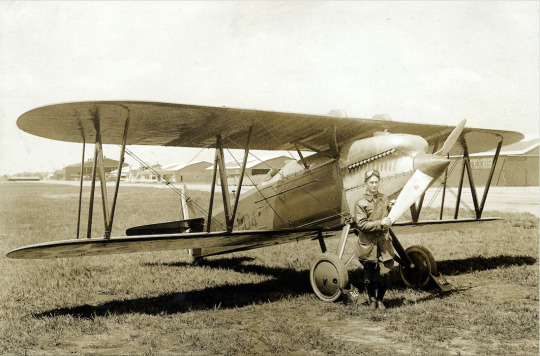
In September of 1923, the Army planned the production of PW-8. This PW-8 had been widened from R-6 racer and even though this PW-8 was considered faster than PW-9 which both have the top speeds in spare of 165m in every hour (mph), it was if not out-performed by Boeing plane, and the cooling system seemed to be vulnerable in combat and harder to maintain.
2. Verville-Sperry R-3 Racer - it was the cantilever wing mono-plane that has the streamlined fuselage and a 2nd aircraft with the totally retractable landing gears, its first being Dayton-Wright Racer. This R-3 racer was known in 1961 as one of those "12 Most Major Aircrafts of all Time" through the famous Mechanics magazine. An R-3 won a Pulitzer Trophy in Ohio in 1924.
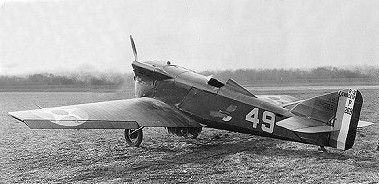
For 1924 Pulitzer, an R-3, won the race with a slow 346 km/h or 215 mph and was piloted by Lt. Harry H. Mills and after the race, those R-3 racers had been sent to McCook Field Museum.
3. Douglas A-20 Havoc - this has a company designation of DB-7 and it was a light bomber, intruder, an American attack, and night warrior aircraft of WWII. It served with some Allied air forces, mainly the USAAF or US Army Air Forces, the VVS or Soviet Air Forces, the AVMF or Soviet Naval Aviation and the RAF or Royal Air Force of the UK. It was used also by the air force France, the Netherlands, Australia, and South Africa during the war, then by Brazil afterwards.
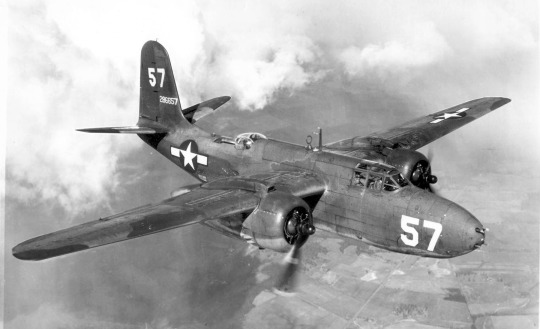
In the British Commonwealth air force, the attack/bomber variants of DB-7 were normally known by their service name “Boston”, whereas the intruder variants and the night fighter were normally known as the Havoc.
4. Huff-Daland LB-1 - this is a US biplane light bomber aircrafts operated in the 1920s.
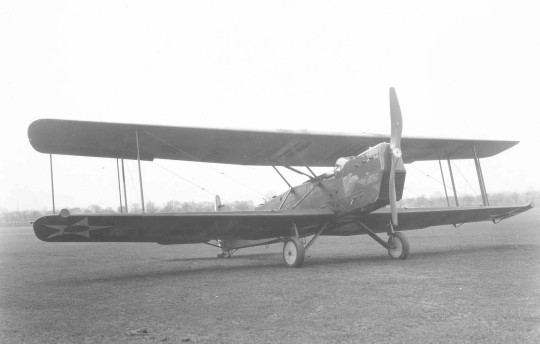
It is derived from an XLB-1 prototype taken in 1923 by the Army, the LB-1 advance aircraft was powered through the solo Packard 2A-2500 engines and carried the added crewman. It established underpowered in the service trials.
5. Martin B-10 - it was the first ever all-metal monoplane bombers to go in regular use and entered the service on 1934 of June. It was the first ever mass-produced bomber where performance base was the best to that of the Army's pursuits.

During its creation time, it became so advanced that it was described as an air power wonder. It was half as fast as with any biplane bomber, also faster than any other contemporary fighter. The only surviving full B-10 is now on display at US Air Force National Museum at Wright-Patterson AF Base near Dayton, OH. The AF Museum conducted a complete search for any existing B-10 remains that eventually heard of the aircraft. The aircraft was reinstated by the (Mobile) 96th Maintenance Squadron, AF Reserve, at the Kelly AF Base, Texas, in between 1973–1976, and then it was placed to show-off in 1976.
6. Douglas C-47 Skytrain - this C-47 was important to the victory of lots of Allied campaigns, precisely those at the jungles of Burma and New Guinea and at the Guadalcanal where this C-47 made it more likely for the Allied troops to oppose the mobility of a light-traveling Japan army.
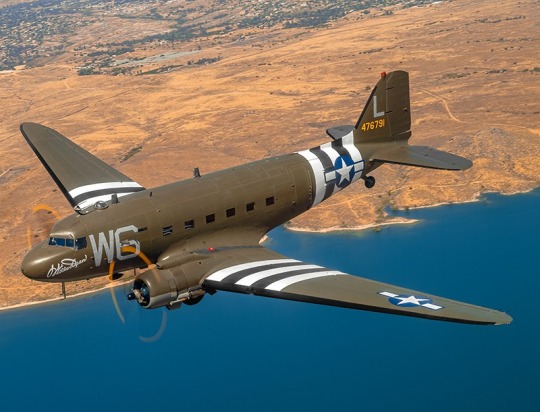
C-47s were used for airlifting supplies to the embattled American forces through the Bastogne Battle and possibly its most significant role in the military aviation.
7. Waco CG-4 - this was the most extensive US cargo/troop military glider of WWII and CG-4As went into action in July 1943 through the Allied attack of Sicily. They partake in the US airborne landings on June 6, 1944 in Normandy, and in some other vital airborne operations in China Burma India stage and in Europe.
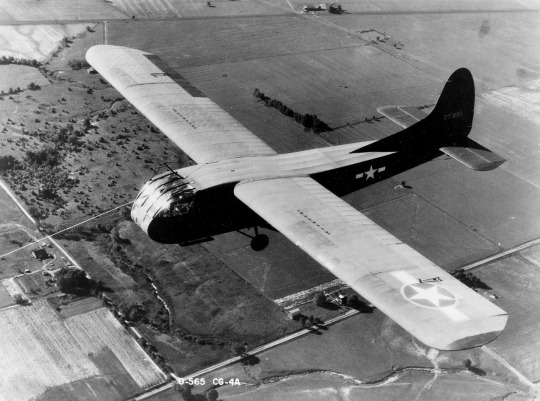
The CG-4A make favor where the small sizes were a benefit that it can land in tiny spaces. The CG-4A was used also to transmit supplies to the partisans in Yugoslavia. Right after WWII ended, most CG-4As remains were declared surplus or spare and almost everything was sold. The last ever known use of CG-4A was during the early 1950s through the USAF with the Arctic detachment aiding technical research.
8. Schweizer TG-3A - All in all, there were 114 TG-3As that has been built for the USAAF use. All of the remaining military TG-3As had been sold to individuals and gliding schools when the war ended.

TG-3A was restored at the National Museum of US Air Force by Spartan Institute of Aeronautics in Oklahoma and was donated to a museum in 1980 of December. In March of 2011, there were about 29 from the TG-3As that has registered in the United States.
9. Boeing P-26 Peashooter - this has been the first ever American all-metal invention fighter aircraft and also the first chase monoplane used by US Army Air Corps. The prototype initially flew in 1932. This type was yet used with U.S. Army Air Corp in the Philippines in as late as the year 1941.
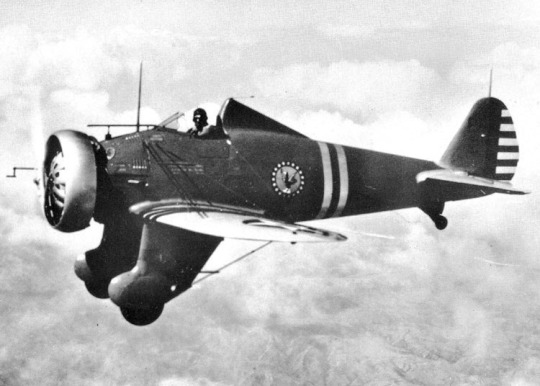
P-26As were flown also by the third PS of the fourth Composite Group, station in the Philippines. In between year 1937 and year 1941, 31 were traded to the hatchling Philippine Army Air Corp. By 1941 of December, the US fighter intensified in the Philippines incorporating 28 P-26s, and 12 of which had been operating with 6th Pursuit Squadrons of the Army Air Corps of the Philippines. Filipino-flown the P-26s claimed 1 G3M and 2-3 Mitsubishi A6M2 Zeros just before the final P-26s were burned on December 24, 1941.
10. Lockheed XH-51 - this was a 3-bladed, sole-engine experimented helicopter that was using a retractable slip landing gear and a rigid rotor.
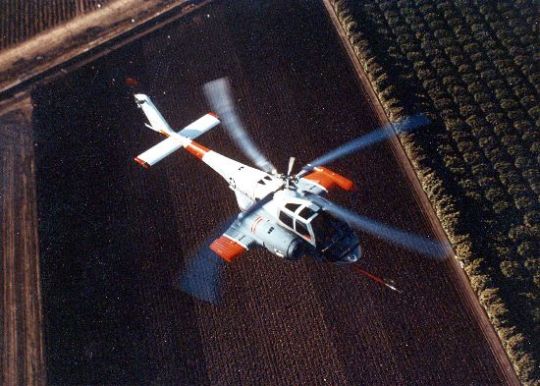
Lockheed started developing the rigid rotor concept together with CL-475 helicopter styled in 1959. This rigid rotor choice was meant that a helicopter was livelier than it could have been with the flapping rotor. The routine of CL-475 encouraged the Lockheed to look for further development. However, in 1962 of February, Lockheed's Model 186, the latest design rigid rotor was chosen to be the winner of the joint Army-Navy plan to evaluate a rigid rotor for the high-speed flight abilities. On June 1964, the NASA ordered the 5-seat, 3-bladed variant as the helicopter test vehicle.
0 notes
Text
Curtiss P-40 Warhawk - Used by US, Australia, Brazil, Canada, China, Finland, New Zealand, South Africa, UK, USSR
Curtiss P-40 Warhawk – Used by US, Australia, Brazil, Canada, China, Finland, New Zealand, South Africa, UK, USSR
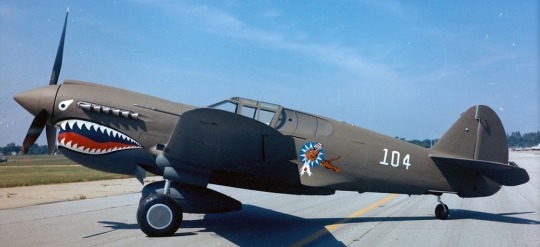
View On WordPress
0 notes
Text
Events 10.14
1066 – The Norman conquest of England begins with the Battle of Hastings. 1322 – Robert the Bruce of Scotland defeats King Edward II of England at the Battle of Old Byland, forcing Edward to accept Scotland's independence. 1586 – Mary, Queen of Scots, goes on trial for conspiracy against Queen Elizabeth I of England. 1656 – Massachusetts enacts the first punitive legislation against the Religious Society of Friends (Quakers). 1758 – Seven Years' War: Frederick the Great suffers a rare defeat at the Battle of Hochkirch. 1773 – The first recorded ministry of education, the Commission of National Education, is formed in the Polish–Lithuanian Commonwealth. 1805 – War of the Third Coalition: A French corps defeats an Austrian attempt to escape encirclement at Ulm. 1806 – War of the Fourth Coalition: Napoleon decisively defeats Prussia at the Battle of Jena–Auerstedt. 1808 – The Republic of Ragusa is annexed by France. 1843 – Irish nationalist Daniel O'Connell arrested by British on charges of criminal conspiracy. 1863 – American Civil War: Confederate troops under the command of A. P. Hill fail to drive the Union Army completely out of Virginia. 1884 – American inventor George Eastman receives a U.S. Government patent on his new paper-strip film. 1888 – Louis Le Prince films the first motion picture, Roundhay Garden Scene. 1898 – The steam ship SS Mohegan sinks near the Lizard peninsula, Cornwall, killing 106. 1908 – The Chicago Cubs defeat the Detroit Tigers, 2–0, clinching the 1908 World Series; this would be their last until winning the 2016 World Series. 1910 – English aviator Claude Grahame-White lands his aircraft on Executive Avenue near the White House in Washington, D.C. 1912 – Former president Theodore Roosevelt is shot and mildly wounded by John Flammang Schrank. With the fresh wound in his chest, and the bullet still within it, Roosevelt delivers his scheduled speech. 1913 – Senghenydd colliery disaster, the United Kingdom's worst coal mining accident, claims the lives of 439 miners. 1915 – World War I: Bulgaria joins the Central Powers. 1920 – Finland and Soviet Russia sign the Treaty of Tartu, exchanging some territories. 1926 – The children's book Winnie-the-Pooh, by A. A. Milne, is first published. 1933 – Germany withdraws from the League of Nations and World Disarmament Conference. 1938 – The first flight of the Curtiss P-40 Warhawk fighter plane. 1939 – World War II: The German submarine U-47 sinks the British battleship HMS Royal Oak within her harbour at Scapa Flow, Scotland. 1940 – World War II: The Balham underground station disaster kills sixty-six people during the London Blitz. 1943 – World War II: Prisoners at the Sobibór extermination camp in Poland revolt against the Germans. 1943 – World War II: The American Eighth Air Force loses 60 of 291 B-17 Flying Fortress during the Second Raid on Schweinfurt. 1943 – World War II: The Second Philippine Republic, a puppet state of Japan, is inaugurated with José P. Laurel as its president. 1944 – World War II: Linked to a plot to assassinate Adolf Hitler, Field Marshal Erwin Rommel is forced to commit suicide. 1947 – Chuck Yeager becomes the first person to exceed the speed of sound. 1949 – The Smith Act trials of Communist Party leaders in the United States convicts eleven defendants of conspiring to advocate the violent overthrow of the federal government. 1952 – Korean War: The Battle of Triangle Hill is the biggest and bloodiest battle of 1952. 1956 – Dr. B. R. Ambedkar converts from Hinduism to Buddhism along with 385,000 of his followers. 1957 – The 23rd Canadian Parliament becomes the only one to be personally opened by the Queen of Canada. 1957 – At least 81 people are killed in the most devastating flood in the history of the Spanish city of Valencia. 1962 – The Cuban Missile Crisis begins when an American reconnaissance aircraft takes photographs of Soviet ballistic missiles being installed in Cuba. 1964 – Martin Luther King Jr. received the Nobel Peace Prize for combating racial inequality through nonviolence. 1964 – The Soviet Presidium and the Communist Party Central Committee each vote to accept Nikita Khrushchev's "voluntary" request to retire from his offices. 1966 – The city of Montreal begins the operation of its underground Montreal Metro rapid transit system. 1968 – The first live TV broadcast by American astronauts in orbit is performed by the Apollo 7 crew. 1968 – The 6.5 Mw Meckering earthquake shook the southwest portion of Western Australia with a maximum Mercalli intensity of IX (Violent), causing $2.2 million in damage and leaving 20–28 people dead. 1968 – Jim Hines becomes the first man ever to break the so-called "ten-second barrier" in the 100-meter sprint with a time of 9.95 seconds. 1973 – In the Thammasat student uprising, over 100,000 people protest in Thailand against the military government. Seventy-seven are killed and 857 are injured by soldiers. 1977 – Anita Bryant gets a pie thrown in her face at a news conference in Des Moines by gay rights activist Tom Higgins for her anti LGBT commentary. 1979 – The first National March on Washington for Lesbian and Gay Rights draws approximately 100,000 people. 1981 – Vice President Hosni Mubarak is elected as the President of Egypt, one week after the assassination of Anwar Sadat. 1982 – U.S. President Ronald Reagan proclaims a War on Drugs. 1991 – Burmese opposition leader Aung San Suu Kyi is awarded the Nobel Peace Prize. 1994 – Yasser Arafat, Yitzhak Rabin and Shimon Peres receive the Nobel Peace Prize for their role in the establishment of the Oslo Accords and the framing of future Palestinian self government. 1998 – Eric Rudolph is charged with six bombings, including the 1996 Centennial Olympic Park bombing in Atlanta, Georgia. 2004 – MK Airlines Flight 1602 crashes during take off from Halifax Stanfield International Airport, killing all seven people on board. 2004 – Pinnacle Airlines Flight 3701 crashes in Jefferson City, Missouri. The two pilots (the aircraft's only occupants) are killed. 2012 – Felix Baumgartner successfully jumps to Earth from a balloon in the stratosphere. 2014 – A snowstorm and avalanche in the Nepalese Himalayas triggered by the remnants of Cyclone Hudhud kills 43 people. 2014 – Utah State University receives a bomb threat against feminist media critic Anita Sarkeesian, who was to give a lecture the next day. 2014 – The Serbia vs. Albania UEFA qualifying match is canceled after 42 minutes due to several incidents on and off the pitch. Albania is eventually awarded a win. 2015 – A suicide bomb attack in Pakistan kills at least seven people and injures 13 others. 2017 – A massive truck bombing in Somalia kills 358 people and injures more than 400 others.
0 notes
Text
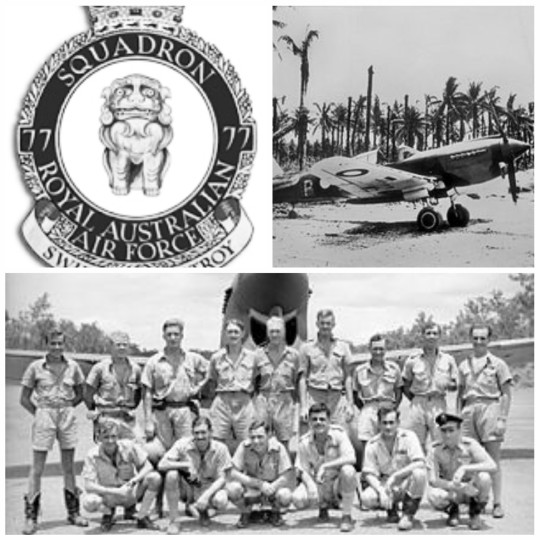
• No. 77 Squadron RAAF
Motto: "Swift to Destroy"
Squadron Code: AM (1942-)
No. 77 Squadron is a Royal Australian Air Force (RAAF) squadron headquartered at RAAF Base Williamtown, New South Wales. The squadron was formed at RAAF Station Pearce, Western Australia, in March 1942 and saw action in the South West Pacific theatre of World War II, operating Curtis P-40 Kittyhawks.
As the Japanese advanced in the South West Pacific during early 1942, the RAAF hurriedly established three fighter units—Nos. 75, 76 and 77 Squadrons—equipped with Curtiss P-40E Kittyhawks recently delivered from the United States. No. 77 Squadron was formed at RAAF Station Pearce, Western Australia, on March 16th, with a complement of three officers and 100 men. Temporarily commanded by Squadron Leader D. F. Forsyth, the unit was initially responsible for the defence of Perth. Squadron Leader Dick Cresswell assumed command on April 20th. The squadron transferred to Batchelor Airfield near Darwin, Northern Territory, in August, the first RAAF fighter unit to be stationed in the area. No. 77 Squadron moved to another of Darwin's satellite airfields, Livingstone, in September. No. 77 Squadron saw action defending Darwin from Japanese air raids and claimed its first aerial victory on November 23rd, 1942, when Cresswell destroyed a Mitsubishi G4M "Betty" bomber. It was the first "kill" for an Australian squadron over the mainland, and the first night victory over Australia. As of December, the unit's strength was twenty-four Kittyhawks.
In February 1943, concurrent with No. 1 Wing and its three Supermarine Spitfire squadrons becoming operational in the Darwin area, No. 77 Squadron was transferred to Milne Bay in New Guinea. Along with Nos. 6, 75 and 100 Squadrons it came under the control of the newly formed No. 71 Wing, part of No. 9 Operational Group, the RAAF's main mobile formation in the South West Pacific Area. No. 77 Squadron registered its first daytime victory on April 11th, when a Kittyhawk shot down a Mitsubishi Zero taking part in a raid on Allied shipping. Three days later the Japanese attacked Milne Bay; the squadron claimed four bombers and a fighter, yet lost one Kittyhawk. By this time, Allied headquarters had finalised plans for a drive north to the Philippines involving heavy attacks on Rabaul and the occupation of territory in New Guinea, New Britain and the Solomon Islands. No. 77 Squadron began moving to Goodenough Island in May 1943, and was fully established and ready for operations June 15th. As Japanese fighter opposition was limited, the squadron took part in several ground-attack missions in New Britain, armed with incendiary and general-purpose bombs, a practice that had been employed by Kittyhawk units in the Middle East. Cresswell remained in command until Squadron Leader "Buster" Brown took over on August 20th. Japanese fighter strength in New Britain and New Guinea increased in September and October, and eight of No. 77 Squadron's Kittyhawks were briefly detached to Nadzab as escorts for the CAC Boomerangs of No. 4 Squadron.
In January 1944, No. 77 Squadron took part in the two largest raids mounted by the RAAF to that time, each involving over seventy aircraft attacking targets in New Britain. It was subsequently assigned to Los Negros in the Admiralty Islands, joining Nos. 76 and 79 Squadrons under No. 73 Wing. . 77 Squadron's ground party went ashore at Los Negros on March 6th, in the middle of a firefight with Japanese forces. Their primary duty was providing air cover for Allied shipping, though no Japanese aircraft were encountered; they also flew ground-attack missions in support of US troops on Manus Island. Following the capture of the Admiralties, which completed the isolation of Rabaul, No. 77 Squadron remained with No. 73 Wing on garrison duty at Los Negros from May to July 1944. Between the 13th of August and 14th of September 1944, the squadron transferred to Noemfoor in western New Guinea to join Nos. 76 and 82 Squadrons as part of No. 81 Wing under No. 10 Operational Group (later the Australian First Tactical Air Force), which had taken over the mobile role previously performed by No. 9 Group and was supporting the American landings along the north coast of New Guinea. Cresswell, now a wing commander, arrived for his second tour of duty as commanding officer. Operating P-40N Kittyhawks, No. 77 Squadron bombed Japanese positions on the Vogelkop Peninsula in October and on Halmahera in November. Cresswell handed over command in March 1945.
The squadron moved to Morotai on April 13th and conducted ground-attack sorties over the Dutch East Indies until June 30th, when it redeployed with No. 81 Wing to Labuan to support the 9th Australian Division in North Borneo until hostilities ended in August 1945. The squadron's tally of aerial victories during the war was seven aircraft destroyed and four "probables", for the loss of eighteen pilots killed. No. 77 Squadron began re-equipping with North American P-51 Mustangs at Labuan in September 1945. No. 77 Squadron was the last of the wing's three flying units to deploy to Japan, arriving at Bofu, a former kamikaze base, in March 1946. Occupation duties proved uneventful, the main operational task being surveillance patrols, but units maintained an intensive training regime and undertook combined exercises with other Allied forces.
No. 77 Squadron went on to serve in the Korean War. The Australian unit was specifically requested by General Douglas MacArthur, commander of UN forces. No. 77 Squadron did not encounter enemy aircraft in the opening phase of the war but often faced intense ground fire. . It suffered its first fatality on July 7th, 1950 when its deputy commander, Squadron Leader Graham Strout, was killed during a raid. He was also the first Australian, and the first non-American UN serviceman, to die in Korea. No. 77 Squadron served in the war until 1953. The squadron's final battle honor was given for the Malayan Emergency from 1960-1966. No. 77 Squadron was deployed also in 2001–02, supporting the war in Afghanistan, and deployed to the Middle East as part of the military intervention against ISIL in 2015–16. No. 77 Squadron is scheduled to convert to the new type of fighter in 2021.
#second world war#world war ii#world war 2#military history#wwii#history#british commonwealth#australian#australian history#australian airforce#royal air force#aviation
41 notes
·
View notes
Photo
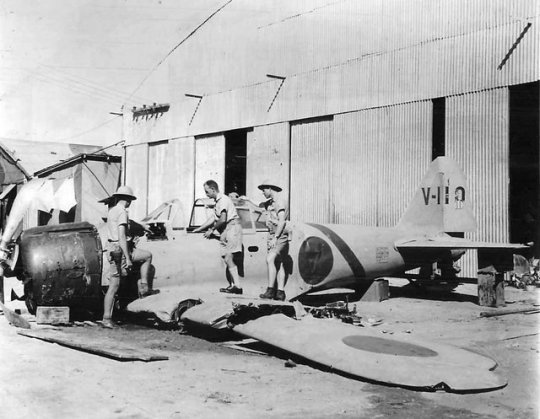
https://pacificeagles.net/defence-port-moresby/
In Defence of Port Moresby
After Rabaul had been captured by the Japanese, Australian forces attempted to consolidate positions on the south coast of New Guinea, particularly at the capital of Port Moresby. With the most skilled and experienced Australian pilots still fighting in Europe and North Africa, the Australian government scrambled to find additional forces to send north. With American forces still making their way across the Pacific, for the time being it was up to the Royal Australian Air Force to stand alone in the defence of Port Moresby.
Existing RAAF strength at Port Moresby was pitiful. Portions of two flying boat squadrons, numbers 11 and 20 Squadron with 6 Catalinas total, and 24 Squadron, a survivor of the Japanese assault on Rabaul that had regrouped at Port Moresby with just 7 Lockheed Hudson medium bombers, comprised the total force available for the defence of the city. This small force was required to not only patrol the approaches to New Guinea to provide early warning of approaching Japanese forces, but also to carry out harassing raids on Rabaul and other enemy positions.
https://www.flickr.com/photos/pacificeagles/33301411092/in/dateposted-public/
With the fall of Rabaul, Port Moresby was within range of Japanese bombers based there. The first raid occurred on the night of the 28th/29th of January, 1942, when H6K Type 97 flying boats from the Yokohama Kokutai appeared over the town in the early hours to carry out a harassing raid. This was followed up on the 2nd of February by an attack during which the Yokohama Ku was joined by 10 of the Chitose Ku’s G3M bombers. With no fighters available, the sole defence was in the form of the anti-aircraft batteries that protected the port and airfield facilities. Damage was on this occasion very light. Initially these raids were unescorted, but soon the Japanese captured Gasmata on the south coast of New Britain, followed a month later by the capture of Lae. Zeros were soon flown into these airfields, from which they could reach not only Port Moresby but also the northern coast of Australia itself.
The small RAAF bomber force did its best to make life difficult for the Japanese. On the night of the 3rd/4th of February, five Catalinas set out for a harassing raid on Rabaul. Chitose Ku A5M fighters attempted a night interception and succeeded in badly damaging one of the flying boats, which was forced to land at Salamaua to make emergency repairs, before returning to Port Moresby a day late. On the 6th, a Hudson was badly damaged on a reconnaissance flight to Rabaul, and had to fly 500 miles back to Port Moresby with three badly wounded crew. For two days starting on the 9th, Hudsons and Catalinas attacked shipping off Gasmata, where the Japanese had just landed. During the second day two Hudsons were shot down by fighters, with 24 Squadron’s skipper SqLdr John Lerew the only survivor – it took him nine days to return to Port Moresby, after he received help from coast watchers.
The first American assistance arrived in the form of the 14th Reconnaissance Squadron, detached from the Hawaiian Air Force specifically to bolster the Australian end of the Hawaii-Australia aerial ferry route. Their first mission was to have been against Rabaul to coincide with the US Navy’s attack on the 21st of February, but when this operation was cancelled the raid was delayed two days. Only five of the assigned nine B-17s made it through abysmal weather to drop bombs on shipping in Simpson Harbour, with indeterminate results.
https://www.flickr.com/photos/pacificeagles/32610911904/in/album-72157681345625026/
The Japanese were also bringing additional bomber forces into the area as the Chitose Kokutai moved more aircraft to Rabaul, where it was joined by the new 4th Kokutai. The 4th was almost wiped out attacking the Lexington, and as a result the 1st Kokutai was transferred from operations in the Indies to reinforce. After a lull the first raid on Port Moresby by this force occurred on the 28th of February, the seaplane base being badly hit with three Catalinas destroyed. The Australians did their best to hit back with what remained of their bombers, mounting a many reconnaissance and harassment missions as they could. It was during a series of these flights that the impending landings at Lae and Salamaua were discovered, resulting in the attack of the 10th of March. The 24th Air Flotilla bomber force launched several raids in support of these landings.
The Allied response to the landings at Lae prompted the Japanese to more aggressively challenge the supply routes to Port Moresby. Flying from the newly captured airfield at Lae, A6M Zeros from the 4th Kokutai’s fighter unit flew to attack Horn Island on the 14th of March in support of a bombing raid. They were challenged by P-40s of the 49th Fighter Group, which were temporarily stationed there whilst transiting to Darwin.
The ‘Tomorrowhawks’
With the Australian situation at Port Moresby looking bleak, the government in Canberra scrambled to find reinforcements to help the garrison. The first batch of P-40 ‘Kittyhawks’ from a large order had arrived at Brisbane, and these were hurriedly assigned to three newly formed squadrons for the defence of New Guinea. Veteran pilots recently returned from the Mediterranean were assigned to lead pilots fresh out of training school as part of 75 Squadron, and the new squadron was given just a few days to familiarise itself with the Curtiss fighter before it was rushed to 7 Mile airfield, the first echelon arriving on the 21st of March. So surprised were the defenders to see the aircraft (which they had derisively nicknamed ‘Tomorrowhawks’ or ‘Neverhawks’) that anti-aircraft crews assumed they were Japanese, and damaged three fighters before they could land.
https://www.flickr.com/photos/pacificeagles/32610910584/in/album-72157681345625026/
Two pilots were immediately ordered into the air to intercept the daily reconnaissance flight from Lae, and the subsequent destruction of a G4M gave the garrison an enormous lift. The very next day, Flight Lieutenant John Jackson, commander of 75 Squadron, led nine of his fighters over the Owen Stanley Mountains in a strafing attack on Lae airfield. Several fighters and bombers were burned on the ground but patrolling Zeros shot down two of the Kittyhawks, with one of the pilots forced to make a month-long trek across New Guinea before he arrived back at Port Moresby.
Realising that the game had changed with the arrival of Australian fighters, the Japanese redoubled their efforts to destroy Port Moresby’s airfields. 19 bombers, the largest raid on the town yet, were sent to attack from high altitude, where the Kittyhawks struggled to meet them due to their lack of supercharged engines. The escorting Zeros were able to attack 75 Squadron with altitude advantage, forcing the Australians to dive away or face destruction. They then strafed 7 Mile, destroying or damaging several Kittyhawks in exchange for one Zero shot down by a ground fire. Other raids occurred over the next few days, with similar results. In just a few days of fighting 75 Squadron had lost 7 out of 17 fighters, and thought was given to withdrawing the inexperienced unit. Further raids over the next few days resulted in less damage, but wore down the defenders still further.
The Japanese began to re-organise their air units prior to the beginning of their second phase offensives. The air units were exhausted following months of activity, and maintenance schedules had fallen by the wayside to the extent that many aircraft were unflyable. There was an inevitable lull in operations as repairs were made and reinforcements brought in. The newly formed 25th Air Flotilla joined the 24th at Rabaul, with five kokutai between them – including the veteran Tainan Ku, which had transferred from the Netherlands East Indies. This force was assembled to win control of the air before the major effort to capture Port Moresby began in May. On the Allied side, American bombers were arriving in Northern Australia in growing numbers, with B-26 Marauders of the 22nd Bomb Group arriving Archerfield in some force and the 19th Bomb Group regrouping nearby following its experiences in Java. In between these two forces was the battered 75 Squadron at 7 Mile.
Reinforcements
Of more immediate interest to the troops at Port Moresby was the arrival of the 3rd Bomb Group’s 8th Bomb Squadron with a few A-24 Banshee bombers. These attacked Salamaua airfield on the 1st of April, planting 500lb bombs on the runway. The Americans even began something of a counter offensive, launching simultaneous raids on Gasmata (by B-25s in their first combat) and Rabaul (by B-17s and 22nd Bomb Group B-26s, also in their first combat) on the 6th of April. One B-26 was lost when it ditched with battle damage, but the crew was recovered by an RAAF Catalina. 75 Squadron returned to Lae a few days later and burned more aircraft on the ground – no protective revetments were available for the Japanese.
American bombers continued raids on Rabaul, in small numbers – half a dozen B-26s, 1 or 2 B-17s at a time. In another first, a squadron of photo-reconnaissance F-4 Lightnings (converted Lockheed P-38s) began operations to keep track of Japanese forces. Success was modest, with the B-26s striking airfields from low level and claiming many aircraft destroyed on the ground. The Marauders also spotted, but failed to sink, the escort carrier Kasuga Maru as it delivered aircraft to Rabaul. On April 18th success was finally achieved when the 22nd Bomb Group managed to sink the transport Komaki Maru just after it unloaded pilots and aircraft from the Tainan Kokutai. This was the first Japanese ship to be sunk in Simpson Harbour.
This American aggression prompted the Japanese to renew their efforts against Port Moresby. With the 1st, 4th and Tainan Kokutai now approaching full strength, plans were laid to prepare the ground for the anticipated invasion of the town planned for early May. On the 21st of April bombers returned to plaster Port Moresby, escorted by Zeros using a new tactic – half the fighters would act as direct escort, whilst the other half would attempt to attack 75 Squadron’s Kittyhawks as they landed following the raid. Three Kittyhawks were lost. During the last 12 days of April a total of 10 raids were mounted against Port Moresby, stretching the defenders to the limit. Aside from the damage done by bombs, strafing Zeros destroyed many aircraft on the ground.
https://www.flickr.com/photos/pacificeagles/33453784505/in/album-72157681345625026/
75 Squadron suffered its blackest day on the 28th of April. The unit had just five Kittyhawks still serviceable, and these rose to challenge the daily raid. Just as they reached the altitude of the incoming G4Ms, escorting Zeros fell on the vulnerable fighters and opened fire on three of them. One was damaged but managed to pull away and return to 7 Mile, the pilot wounded. The other two, one piloted by FL John Jackson, were both shot down with the pilots killed. 75 Squadron had lost its leader, and the unit was shattered with no flyable Kittyhawks remaining. It was withdrawn a few days later, having lost 22 aircraft and 12 pilots killed in 44 days of operations. 26 P-39 Airacobras from the 8th Pursuit Group led by newly promoted LtCol Boyd Wagner, a Philippines veteran and the first USAAF ‘ace’ of the war, arrived to take over the defence of the town. On their first mission the P-39s claimed four Zeros shot down but lost four Airacobras in return.
The reinforcements arrived just in time. American intelligence had analysed Japanese radio traffic and determined that the ‘MO’ Operation to capture Port Moresby was about to be launched. B-26s launched additional raids on Rabaul, hoping to reduce the usefulness of that base during the upcoming battle, but they failed to cause much damage and lost another Marauder in the effort. It would fall to the Navy to make the major effort to forestall the offensive, and in Pearl Harbor Admiral Nimitz had already gathered his powerful carrier forces in the South Pacific especially fr the purposes of blunting the Japanese attack. The stage was set for the first climactic carrier battle of the war, in a place west of New Guinea called the Coral Sea.
1 note
·
View note
Video
Curtiss P-40F Kittyhawk 'X-17' (VH-PIV) by Alan Wilson Via Flickr: This is the first Merlin engined P-40 to appear at shows in the UK. US military serial '41-19841'. msn reported as both 19503 & 2991. This is a TFC aircraft and had only arrived after restoration in Australia the week before this show. Parked on the grass flightline. Flying Legends 2011. Duxford. 10-7-2011
6 notes
·
View notes
Video
Curtiss Kittyhawk IV ‘FX760 / GA-?’ (really A29-556) by Alan Wilson Via Flickr: c/n 29863. Built for Australia in 1943 as a P-40N and allocated US military serial ’42-106101’. Immediately transported to Australia and given the RAAF serial ‘A29-556’. In service from October 1943 until written off when struck by a landing aircraft in May 1944. It was then dismantled for spares. In 1974 it was one of 13 P-40 wrecks recovered from New Guinea to the USA. In 1987 the RAF Museum swapped a Spitfire XVI gate guard for a complete P-40, restored to static display standards. The fuselage of A29-556 was used in the rebuild and the completed rebuilt went on display at Hendon in May 1992, painted in 112sqn markings. It was stored between 1999 and 2003, during which further investigation revealed its true identity. It then returned to Hendon where it remains on display in the Historic Main Hangars. RAF Museum, Hendon, London, UK. 22-3-2015
0 notes
Video
Curtiss Kittyhawk IV ‘FX760 / GA-?’ (really A29-556) by Alan Wilson Via Flickr: Built for Australia in 1943 as a P-40N and allocated US military serial ’42-106101’. Immediately transported to Australia and given the RAAF serial ‘A29-556’. In service from October 1943 until written off when struck by a landing aircraft in May 1944. It was then dismantled for spares. In 1974 it was one of 13 P-40 wrecks recovered from New Guinea to the USA. In 1987 the RAF Museum swapped a Spitfire XVI gate guard for a complete P-40, restored to static display standards. The fuselage of A29-556 was used in the rebuild and the completed rebuilt went on display at Hendon in May 1992, painted in 112sqn markings. It was stored between 1999 and 2003, during which further investigation revealed its true identity. It then returned to Hendon where it remains on display in the Historic Main Hangars. RAF Museum, Hendon, London, UK. 28th May 2016
0 notes
Text
Events 10.14
1066 – Norman conquest of England: Battle of Hastings: In England on Senlac Hill, seven miles from Hastings, the Norman forces of William the Conqueror defeat the English army and kill King Harold II of England. 1322 – Robert the Bruce of Scotland defeats King Edward II of England at Byland, forcing Edward to accept Scotland's independence. 1582 – Because of the adoption of the Gregorian calendar this day does not exist in this year in Italy, Poland, Portugal and Spain. 1586 – Mary, Queen of Scots, goes on trial for conspiracy against Elizabeth I of England. 1656 – Massachusetts enacts the first punitive legislation against the Religious Society of Friends (Quakers). The marriage of church-and-state in Puritanism makes them regard the Quakers as spiritually apostate and politically subversive. 1758 – Seven Years' War: Austria defeats Prussia at the Battle of Hochkirch. 1773 – The first recorded Ministry of Education, the Commission of National Education, is formed in the Polish–Lithuanian Commonwealth. 1773 – Just before the beginning of the American Revolutionary War, several of the British East India Company's tea ships are set ablaze at the old seaport of Annapolis, Maryland. 1805 – Battle of Elchingen, France defeats Austria. 1806 – Battle of Jena–Auerstedt France defeats Prussia. 1808 – The Republic of Ragusa is annexed by France. 1843 – Irish nationalist Daniel O'Connell arrested by British on charges of criminal conspiracy. 1863 – American Civil War: Battle of Bristoe Station: Confederate troops under the command of General Robert E. Lee fail to drive the Union Army completely out of Virginia. 1884 – American inventor George Eastman receives a U.S. Government patent on his new paper-strip photographic film. 1888 – Louis Le Prince films first motion picture: Roundhay Garden Scene. 1898 – The steamer ship SS Mohegan sinks after striking the Manacles, near The Lizard peninsula, Cornwall, United Kingdom, killing 106. 1908 – The Chicago Cubs defeat the Detroit Tigers, 2–0, clinching the World Series; this would be their last until clinching the 2016 World Series. 1910 – English aviator Claude Grahame-White lands his Farman Aircraft biplane on Executive Avenue near the White House in Washington, D.C. 1912 – While campaigning in Milwaukee, the former President of the United States, Theodore Roosevelt, is shot and mildly wounded by John Schrank, a mentally-disturbed saloon keeper. With the fresh wound in his chest, and the bullet still within it, Mr. Roosevelt still carries out his scheduled public speech. 1913 – Senghenydd colliery disaster, the United Kingdom's worst coal mining accident claims the lives of 439 miners. 1915 – World War I: Bulgaria joins the Central Powers. 1920 – Part of Petsamo Province is ceded by the Soviet Union to Finland. 1926 – The children's book Winnie-the-Pooh, by A. A. Milne, is first published. 1933 – Nazi Germany withdraws from the League of Nations and World Disarmament Conference. 1938 – The first flight of the Curtiss P-40 Warhawk fighter plane. 1939 – World War II: The German submarine U-47 sinks the British battleship HMS Royal Oak within her harbour at Scapa Flow, Scotland. 1940 – World War II: The Balham underground station disaster kills sixty-six people during the London Blitz. 1943 – World War II: Prisoners at the Sobibór extermination camp in Poland revolt against the Germans. 1943 – World War II: The American Eighth Air Force loses 60 of 291 B-17 Flying Fortress during its "mission 115", the Second Raid on Schweinfurt. 1943 – World War II: The Second Philippine Republic, a puppet of the Empire of Japan, was inaugurated with Jose P. Laurel as its president. 1944 – World War II: Athens, Greece, is liberated by British Army troops entering the city as the Wehrmacht pulls out. This clears the way for the Greek government-in-exile to return to its historic capital city, with Georgios Papandreou, as the head of government. 1944 – World War II: Linked to a plot to assassinate Adolf Hitler, Field Marshal Erwin Rommel is forced to commit suicide. 1947 – Captain Chuck Yeager of the United States Air Force flies a Bell X-1 rocket-powered experimental aircraft, the Glamorous Glennis, faster than the speed of sound at Mach 1.06 (700 miles per hour (1,100 km/h; 610 kn) over the high desert of Southern California and becomes the first pilot and the first airplane to do so in level flight. 1949 – Eleven leaders of the American Communist Party are convicted, after a nine-month trial in a Federal District Court, of conspiring to advocate the violent overthrow of the U.S. Federal Government. 1949 – Chinese Civil War: Chinese Communist forces occupy Guangzhou. 1952 – Korean War: United Nations and South Korean forces launch Operation Showdown against Chinese strongholds at the Iron Triangle. The resulting Battle of Triangle Hill is the biggest and bloodiest battle of 1952. 1956 – Dr. B. R. Ambedkar, the Indian Untouchable caste leader, converts to Buddhism along with 385,000 of his followers (see Neo-Buddhism). 1957 – Queen Elizabeth II becomes the first Canadian monarch to open a session of the Canadian Parliament, presenting her Speech from the throne in Ottawa, Ontario, Canada. 1957 – At least 81 people are killed in the most devastating flood in the history of the Spanish city of Valencia. 1958 – The District of Columbia's Bar Association votes to accept African-Americans as member attorneys. 1962 – The Cuban Missile Crisis begins: A U.S. Air Force U-2 reconnaissance plane and its pilot flies over the island of Cuba and takes photographs of Soviet SS-4 Sandal missiles being installed and erected in Cuba. 1964 – Martin Luther King Jr. received the Nobel Peace Prize for combating racial inequality through nonviolence. 1964 – Leonid Brezhnev becomes the General Secretary of the Communist Party of the Soviet Union, and thereby, along with his allies, such as Alexei Kosygin, the leader of the Union of Soviet Socialist Republics (USSR), ousting the former monolithic leader Nikita Khrushchev, and sending him into retirement as a nonperson in the USSR. 1966 – The city of Montreal begins the operation of its underground Montreal Metro rapid transit system. 1967 – Vietnam War: American folk singer and activist Joan Baez is arrested concerning a physical blockade of the U.S. Army's induction center in Oakland, California. 1968 – Vietnam War: Twenty-seven soldiers are arrested at the Presidio of San Francisco in California for their peaceful protest of stockade conditions and the Vietnam War. 1968 – Vietnam War: The United States Department of Defense announces that the U.S. Army and U.S. Marine Corps will send about 24,000 soldiers and Marines back to Vietnam for involuntary second tours of duty in the combat zone there. 1968 – Apollo program: The first live TV broadcast by American astronauts in orbit performed by the Apollo 7 crew. 1968 – The 6.5 Mw Meckering earthquake shook the southwest portion of Western Australia with a maximum Mercalli intensity of IX (Violent), causing $2.2 million in damage and leaving 20–28 people dead. 1968 – Jim Hines of the United States of America becomes the first man ever to break the so-called "ten-second barrier" in the 100-meter sprint in the Summer Olympic Games held in Mexico City with a time of 9.95 seconds. 1969 – The United Kingdom introduces the British fifty-pence coin, which replaces, over the following years, the British ten-shilling note, in anticipation of the decimalization of the British currency in 1971, and the abolition of the shilling as a unit of currency anywhere in the world. 1973 – In the Thammasat student uprising over 100,000 people protest in Thailand against the Thanom military government, 77 are killed and 857 are injured by soldiers. 1979 – The first Gay Rights March on Washington, D.C., the National March on Washington for Lesbian and Gay Rights, demands "an end to all social, economic, judicial, and legal oppression of lesbian and gay people", and draws approximately 100,000 people. 1981 – Citing official misconduct in the investigation and trial, Amnesty International charges the U.S. Federal Government with holding Richard Marshall of the American Indian Movement as a political prisoner. 1981 – Vice President Hosni Mubarak is elected as the President of Egypt one week after the assassination of the President of Egypt, Anwar Sadat. 1982 – U.S. President Ronald Reagan proclaims a War on Drugs. 1983 – Maurice Bishop, Prime Minister of Grenada, is overthrown and later executed in a military coup d'état led by Bernard Coard. 1991 – Burmese opposition leader Aung San Suu Kyi is awarded the Nobel Peace Prize. 1994 – The Palestinian leader, Yasser Arafat, The Prime Minister of Israel, Yitzhak Rabin, and the Foreign Minister of Israel, Shimon Peres, receive the Nobel Peace Prize for their role in the establishment of the Oslo Accords and the framing of the future Palestinian Self Government. 1998 – Eric Rudolph is charged with six bombings including the 1996 Centennial Olympic Park bombing in Atlanta, Georgia. 2012 – Felix Baumgartner successfully jumped to Earth from a helium balloon in the stratosphere in the Red Bull Stratos project. 2014 – A snowstorm and avalanche in the Nepalese Himalayas triggered by the remnants of Cyclone Hudhud kills 43 people. 2014 – Utah State University receives a bomb threat against feminist media critic Anita Sarkeesian, who was to give a lecture the next day. 2014 – In a football match between Serbia and Albania for the UEFA Euro 2016 qualifiers in Belgrade, Serbia, riots erupt after a drone carrying the flag of Greater Albania is flown in the pitch. Several Albanian players are injured through physical assaults, and the incident creates a diplomatic dispute between the two nations. 2015 – A suicide bomb attack in Pakistan, kills at least seven people and injures 13 others. 2017 – A massive truck bombing in Somalia kills 358 people and injures more than 400 others.
0 notes
Text
Events 10.14
1066 – Norman Conquest: Battle of Hastings: In England on Senlac Hill, seven miles from Hastings, the Norman forces of William the Conqueror defeat the English army and kill King Harold II of England. 1322 – Robert the Bruce of Scotland defeats King Edward II of England at Byland, forcing Edward to accept Scotland's independence. 1582 – Because of the adoption of the Gregorian calendar this day does not exist in this year in Italy, Poland, Portugal and Spain. 1586 – Mary, Queen of Scots, goes on trial for conspiracy against Elizabeth I of England. 1656 – Massachusetts enacts the first punitive legislation against the Religious Society of Friends (Quakers). The marriage of church-and-state in Puritanism makes them regard the Quakers as spiritually apostate and politically subversive. 1758 – Seven Years' War: Austria defeats Prussia at the Battle of Hochkirch. 1773 – The first recorded Ministry of Education, the Commission of National Education, is formed in the Polish–Lithuanian Commonwealth. 1773 – Just before the beginning of the American Revolutionary War, several of the British East India Company's tea ships are set ablaze at the old seaport of Annapolis, Maryland. 1805 – Battle of Elchingen, France defeats Austria. 1806 – Battle of Jena–Auerstedt France defeats Prussia. 1808 – The Republic of Ragusa is annexed by France. 1843 – Irish nationalist Daniel O'Connell arrested by British on charges of criminal conspiracy. 1863 – American Civil War: Battle of Bristoe Station: Confederate troops under the command of General Robert E. Lee fail to drive the Union Army completely out of Virginia. 1884 – American inventor George Eastman receives a U.S. Government patent on his new paper-strip photographic film. 1888 – Louis Le Prince films first motion picture: Roundhay Garden Scene. 1898 – The steamer ship SS Mohegan sinks after impacting the Manacles near Cornwall, United Kingdom, killing 106. 1908 – The Chicago Cubs defeat the Detroit Tigers, 2–0, clinching the World Series; this would be their last until clinching the 2016 World Series. 1910 – English aviator Claude Grahame-White lands his Farman Aircraft biplane on Executive Avenue near the White House in Washington, D.C. 1912 – While campaigning in Milwaukee, the former President of the United States, Theodore Roosevelt, is shot and mildly wounded by John Schrank, a mentally-disturbed saloon keeper. With the fresh wound in his chest, and the bullet still within it, Mr. Roosevelt still carries out his scheduled public speech. 1913 – Senghenydd colliery disaster, the United Kingdom's worst coal mining accident claims the lives of 439 miners. 1915 – World War I: Bulgaria joins the Central Powers. 1920 – Part of Petsamo Province is ceded by the Soviet Union to Finland. 1926 – The children's book Winnie-the-Pooh, by A. A. Milne, is first published. 1933 – Nazi Germany withdraws from the League of Nations and World Disarmament Conference. 1938 – The first flight of the Curtiss P-40 Warhawk fighter plane. 1939 – World War II: The German submarine U-47 sinks the British battleship HMS Royal Oak within her harbour at Scapa Flow, Scotland. 1940 – World War II: The Balham underground station disaster kills sixty-six people during the London Blitz. 1943 – World War II: Prisoners at the Sobibór extermination camp in Poland revolt against the Germans. 1943 – World War II: The American Eighth Air Force loses 60 of 291 B-17 Flying Fortress during the Second Raid on Schweinfurt. 1943 – World War II: The Second Philippine Republic, a puppet of the Empire of Japan, was inaugurated with Jose P. Laurel as its president. 1944 – World War II: Athens, Greece, is liberated by British Army troops entering the city as the Wehrmacht pulls out. This clears the way for the Greek government-in-exile to return to its historic capital city, with Georgios Papandreou, as the head of government. 1944 – World War II: Linked to a plot to assassinate Adolf Hitler, Field Marshal Erwin Rommel is forced to commit suicide. 1947 – Captain Chuck Yeager of the United States Air Force flies a Bell X-1 rocket-powered experimental aircraft, the Glamorous Glennis, faster than the speed of sound at Mach 1.06 (700 miles per hour (1,100 km/h; 610 kn) over the high desert of Southern California and becomes the first pilot and the first airplane to do so in level flight. 1949 – Eleven leaders of the American Communist Party are convicted, after a nine-month trial in a Federal District Court, of conspiring to advocate the violent overthrow of the U.S. Federal Government. 1949 – Chinese Civil War: Chinese Communist forces occupy Guangzhou. 1952 – Korean War: United Nations and South Korean forces launch Operation Showdown against Chinese strongholds at the Iron Triangle. The resulting Battle of Triangle Hill is the biggest and bloodiest battle of 1952. 1956 – Dr. B. R. Ambedkar, the Indian Untouchable caste leader, converts to Buddhism along with 385,000 of his followers (see Neo-Buddhism). 1957 – Queen Elizabeth II becomes the first Canadian monarch to open up an annual session of the Canadian Parliament, presenting her Speech from the throne in Ottawa, Ontario, Canada. 1957 – At least 81 people are killed in the most devastating flood in the history of the Spanish city of Valencia. 1958 – The District of Columbia's Bar Association votes to accept African-Americans as member attorneys. 1962 – The Cuban Missile Crisis begins: A U.S. Air Force U-2 reconnaissance plane and its pilot flies over the island of Cuba and takes photographs of Soviet SS-4 Sandal missiles being installed and erected in Cuba. 1964 – Martin Luther King Jr. received the Nobel Peace Prize for combating racial inequality through nonviolence. 1964 – Leonid Brezhnev becomes the General Secretary of the Communist Party of the Soviet Union, and thereby, along with his allies, such as Alexei Kosygin, the leader of the Union of Soviet Socialist Republics (USSR), ousting the former monolithic leader Nikita Khrushchev, and sending him into retirement as a nonperson in the USSR. 1966 – The city of Montreal begins the operation of its underground Montreal Metro rapid transit system. 1967 – Vietnam War: American folk singer and activist Joan Baez is arrested concerning a physical blockade of the U.S. Army's induction center in Oakland, California. 1968 – Vietnam War: Twenty-seven soldiers are arrested at the Presidio of San Francisco in California for their peaceful protest of stockade conditions and the Vietnam War. 1968 – Vietnam War: The United States Department of Defense announces that the U.S. Army and U.S. Marine Corps will send about 24,000 soldiers and Marines back to Vietnam for involuntary second tours of duty in the combat zone there. 1968 – Apollo program: The first live TV broadcast by American astronauts in orbit performed by the Apollo 7 crew. 1968 – The 6.5 Mw Meckering earthquake shook the southwest portion of Western Australia with a maximum Mercalli intensity of IX (Violent), causing $2.2 million in damage and leaving 20–28 people dead. 1968 – Jim Hines of the United States of America becomes the first man ever to break the so-called "ten-second barrier" in the 100-meter sprint in the Summer Olympic Games held in Mexico City with a time of 9.95 seconds. 1969 – The United Kingdom introduces the British fifty-pence coin, which replaces, over the following years, the British ten-shilling note, in anticipation of the decimalization of the British currency in 1971, and the abolition of the shilling as a unit of currency anywhere in the world. 1973 – In the Thammasat student uprising over 100,000 people protest in Thailand against the Thanom military government, 77 are killed and 857 are injured by soldiers. 1979 – The first Gay Rights March on Washington, D.C., the National March on Washington for Lesbian and Gay Rights, demands "an end to all social, economic, judicial, and legal oppression of lesbian and gay people", and draws approximately 100,000 people. 1981 – Citing official misconduct in the investigation and trial, Amnesty International charges the U.S. Federal Government with holding Richard Marshall of the American Indian Movement as a political prisoner. 1981 – Vice President Hosni Mubarak is elected as the President of Egypt one week after the assassination of the President of Egypt, Anwar Sadat. 1982 – U.S. President Ronald Reagan proclaims a War on Drugs. 1983 – Maurice Bishop, Prime Minister of Grenada, is overthrown and later executed in a military coup d'état led by Bernard Coard. 1991 – Burmese opposition leader Aung San Suu Kyi is awarded the Nobel Peace Prize. 1994 – The Palestinian leader, Yasser Arafat, The Prime Minister of Israel, Yitzhak Rabin, and the Foreign Minister of Israel, Shimon Peres, receive the Nobel Peace Prize for their role in the establishment of the Oslo Accords and the framing of the future Palestinian Self Government. 1998 – Eric Rudolph is charged with six bombings including the 1996 Centennial Olympic Park bombing in Atlanta, Georgia. 2012 – Felix Baumgartner successfully jumped to Earth from a helium balloon in the stratosphere in the Red Bull Stratos project. 2014 – A snowstorm and avalanche in the Nepalese Himalayas triggered by the remnants of Cyclone Hudhud kills 43 people. 2014 – Utah State University receives a bomb threat against feminist media critic Anita Sarkeesian, who was to give a lecture the next day. 2015 – A suicide bomb attack in Pakistan, kills at least seven people and injures 13 others.
0 notes



